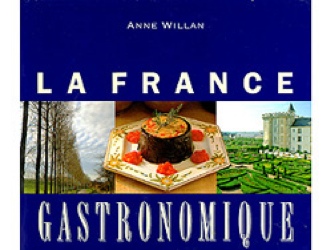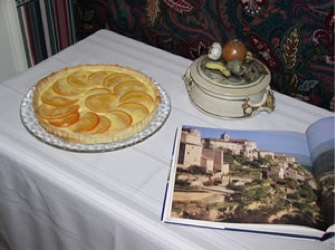 Faites-vous cuire la nourriture française ?
Faites-vous cuire la nourriture française ?
Jim explores the wonders of French provincial
cooking.
If I told you the story of how I got here, I'd
never be able to tell you about here. Suffice it to say: I retired, I took a
beginning course in French at SLCC Meramec, I started exploring things French, I
read a couple of books by Peter
Mayle, and that led to the exploration of French provincial food and
wine. Voila!
 Stephen and I have a couple of couple-friends who have entertained us royally
for years without our returning the favor. So I determined to feed Tom and Tom
and Dennis and Charles a Provençal menu. I searched through our six-shelf
cooking library and came up with a wonderful out-of-print book by Ann Willan,
called La France Gastronomique. You can still get it at various and sundry
places on the web for between $40 and $60. It was just one of friend, Jan's
wonderful gifts to us over the years. I stole the picture from chef.com.au.
Stephen and I have a couple of couple-friends who have entertained us royally
for years without our returning the favor. So I determined to feed Tom and Tom
and Dennis and Charles a Provençal menu. I searched through our six-shelf
cooking library and came up with a wonderful out-of-print book by Ann Willan,
called La France Gastronomique. You can still get it at various and sundry
places on the web for between $40 and $60. It was just one of friend, Jan's
wonderful gifts to us over the years. I stole the picture from chef.com.au.
We dickered with the guys and finally arrived at the following menu, all but the soup from Willan's book:
Potage de Potrion (ou Citrouelle)
Papeton d'Aubergines
Filet de Poisson en Tapenade
Tarte aux Oranges Confites
You can see the festive eggplant dish on the cover of Willan's book, above. It is basically a ratatouille, dressed up in tuxedo. To get the effect of a tiara, after you cook the vegetables, you line a charlotte mold with the eggplant skin, mix the ratatouille with bread and eggs, bake it in a water bath, and then unmold it onto an attractive plate. Mine turned out OK, but not the perfect example on the cover. Other than the sheer beauty of serving up your veggies this way, I learned a lot about a different kind of cooking. First the eggplant is split and baked, and the pulp scooped out, saving the skins for decoration. Then the veggies, started in a heavy deep covered skillet (I use Crueset, discussed in this blog), are finished slowly in the oven, rather than on the stove. Also, I didn't own a charlotte mold, and so had to go out to the Kitchen Conservatory and buy one.
The Fish in Tapenade turned out to be a real challange. Good fresh whitefish is really hard to get these days, especially something similar to what you'd get from the Mediterranean Sea. I thought I would try to find sea bass, but thank God I didn't, because Dennis gave a lecture on how the species is endangered (unfortunately, I needed to hear this lecture). I called two local fish places. The guy with the charming Italian accent at Rizzo's said, "Ain't nobody got no whitefish this Saturday!" So, duty to culinary fidelity done, I went to CostCo, checked with Stephen on the cell phone, and bought frozen cod at the last moment.
Back at home, the Willan recipe calls for the tapenade to be a blend of black olives, capers, anchovies and garlic, spread right on the cooked fish. So I made that, delicious. But then, what if there are squeamish eaters in the group? Another problem to solve. How do I season the fish now that the tapenade is going to be offered on the side? I went to the internet and searched for "baked cod provençal." Well, at least I left out the "icelandic!" Much to my surprise, there were scores of such recipes. Immediately the solution became apparent: chopped tomatoes, seasoned with provençal herbs and olive oil, would baste the cod as it baked. Of course, after all that trouble, everybody put the tapenade right on their fish, and none was left at the end of the meal.
But here is my pride and joy! And what a culinary summit to ascend: Tarte aux Oranges Confites!
 While I am trying to describe making it, you might as well look at this fabulous
confection, along with the facing picture of the Provençe chapter in
Willan's book, which is of the provençal château at Grignan, home of
Madame
de Sévigné in the mid-late 17th Century. I've never made a
tart using a tart pan, let alone tried to make the sweet French pastry dough
known as pâte brisée.
I've never made crystallized orange slices
before, although I did once make crystallized violets. And I've never tried to
make a French custard as rich as this one. Believe it or not, I started on
Monday and finished on Saturday.
While I am trying to describe making it, you might as well look at this fabulous
confection, along with the facing picture of the Provençe chapter in
Willan's book, which is of the provençal château at Grignan, home of
Madame
de Sévigné in the mid-late 17th Century. I've never made a
tart using a tart pan, let alone tried to make the sweet French pastry dough
known as pâte brisée.
I've never made crystallized orange slices
before, although I did once make crystallized violets. And I've never tried to
make a French custard as rich as this one. Believe it or not, I started on
Monday and finished on Saturday.
First there was the second trip to Kitchen Conservatory for the tart pan and the parchment paper. I resisted buying the $70 marble rolling pin and pastry board, however. Next time. The next day, I sliced the oranges and boiled them in sugar syrup, which they had to sit in for 24 hours. Then I drained them and let them dry; that was several more hours. Next, the rich pâte brisée has to be made and stored in the refrigerator over night. Next morning, rolling out the dough was like nothing I'd ever experienced. Obviously there's a knack to it, and I did manage to line the tart pan successfully. Next, you lightly brown the tart lined with parchment and weighted with beans. (I used soy beans, for a healthy touch.) The beans and paper are removed after baking. Finally, the candied orange slices line the crust, and a cream and egg custard is poured over all and baked briefly.
I almost had a nervous bakedown doing this, but the results were both beautiful and delicious. The guys were delighted with the tart and with the French coffee with chicory, just like my Walloon papa, Fernand, taught me to make so many decades ago.
I asked Stephen to come up with a soup to start the meal. His inspiration came from the wonderful collection of French vegetarian recipies in the book, This Good Food. Brother Victor-Antoine d'Avila Latourrette has written several books based on his work as a cook at Our Lady of the Resurrection Monastery in LaGrangeville, NY. Stephen chose the recipe for Potage au Potrion (pumpkin soup), which the book tells us is a rather common winter soup in France. In addition to the pumpkin (also called citrouielle in French—I found out reading Cendrillon in French class), this puréed soup contains savory vegetables, milk, spices. However, Stephen never just makes a recipe, he works magic on it. This time the magic ingredients were a bit of the leftover orange-flavored syrup from the tart preparation and yoghurt. It was fabulous, served from the white terrine that my brother and his wife gave me several years ago.
After our French provincial dinner, we went to the entertainment room to watch the hilarous Le dîner au cons. (This was another gift from the French class.) A group of French male artists and intellectuals find it entirely too amusing to host a dinner for "idiots" found on the metro, in their offices, or in the park. They laugh it up at these guys' expense until Pierre (Thierry Lhermitte), the distressed "hero" is put properly in his place by an idiot with a heart, François (Jacques Villeret). But, once a fool, always a fool, as François wins back and then looses again something of value to Pierre.
If when you think of French food, you think of French fries, François has a tower he wants to show you.
Avec remerciements à mon professeur français et a la France.
 Stephen and I have a couple of couple-friends who have entertained us royally
for years without our returning the favor. So I determined to feed Tom and Tom
and Dennis and Charles a Provençal menu. I searched through our six-shelf
cooking library and came up with a wonderful out-of-print book by Ann Willan,
called La France Gastronomique. You can still get it at various and sundry
places on the web for between $40 and $60. It was just one of friend, Jan's
wonderful gifts to us over the years. I stole the picture from chef.com.au.
Stephen and I have a couple of couple-friends who have entertained us royally
for years without our returning the favor. So I determined to feed Tom and Tom
and Dennis and Charles a Provençal menu. I searched through our six-shelf
cooking library and came up with a wonderful out-of-print book by Ann Willan,
called La France Gastronomique. You can still get it at various and sundry
places on the web for between $40 and $60. It was just one of friend, Jan's
wonderful gifts to us over the years. I stole the picture from chef.com.au.We dickered with the guys and finally arrived at the following menu, all but the soup from Willan's book:
Potage de Potrion (ou Citrouelle)
Papeton d'Aubergines
Filet de Poisson en Tapenade
Tarte aux Oranges Confites
You can see the festive eggplant dish on the cover of Willan's book, above. It is basically a ratatouille, dressed up in tuxedo. To get the effect of a tiara, after you cook the vegetables, you line a charlotte mold with the eggplant skin, mix the ratatouille with bread and eggs, bake it in a water bath, and then unmold it onto an attractive plate. Mine turned out OK, but not the perfect example on the cover. Other than the sheer beauty of serving up your veggies this way, I learned a lot about a different kind of cooking. First the eggplant is split and baked, and the pulp scooped out, saving the skins for decoration. Then the veggies, started in a heavy deep covered skillet (I use Crueset, discussed in this blog), are finished slowly in the oven, rather than on the stove. Also, I didn't own a charlotte mold, and so had to go out to the Kitchen Conservatory and buy one.
The Fish in Tapenade turned out to be a real challange. Good fresh whitefish is really hard to get these days, especially something similar to what you'd get from the Mediterranean Sea. I thought I would try to find sea bass, but thank God I didn't, because Dennis gave a lecture on how the species is endangered (unfortunately, I needed to hear this lecture). I called two local fish places. The guy with the charming Italian accent at Rizzo's said, "Ain't nobody got no whitefish this Saturday!" So, duty to culinary fidelity done, I went to CostCo, checked with Stephen on the cell phone, and bought frozen cod at the last moment.
Back at home, the Willan recipe calls for the tapenade to be a blend of black olives, capers, anchovies and garlic, spread right on the cooked fish. So I made that, delicious. But then, what if there are squeamish eaters in the group? Another problem to solve. How do I season the fish now that the tapenade is going to be offered on the side? I went to the internet and searched for "baked cod provençal." Well, at least I left out the "icelandic!" Much to my surprise, there were scores of such recipes. Immediately the solution became apparent: chopped tomatoes, seasoned with provençal herbs and olive oil, would baste the cod as it baked. Of course, after all that trouble, everybody put the tapenade right on their fish, and none was left at the end of the meal.
But here is my pride and joy! And what a culinary summit to ascend: Tarte aux Oranges Confites!
 While I am trying to describe making it, you might as well look at this fabulous
confection, along with the facing picture of the Provençe chapter in
Willan's book, which is of the provençal château at Grignan, home of
Madame
de Sévigné in the mid-late 17th Century. I've never made a
tart using a tart pan, let alone tried to make the sweet French pastry dough
known as pâte brisée.
I've never made crystallized orange slices
before, although I did once make crystallized violets. And I've never tried to
make a French custard as rich as this one. Believe it or not, I started on
Monday and finished on Saturday.
While I am trying to describe making it, you might as well look at this fabulous
confection, along with the facing picture of the Provençe chapter in
Willan's book, which is of the provençal château at Grignan, home of
Madame
de Sévigné in the mid-late 17th Century. I've never made a
tart using a tart pan, let alone tried to make the sweet French pastry dough
known as pâte brisée.
I've never made crystallized orange slices
before, although I did once make crystallized violets. And I've never tried to
make a French custard as rich as this one. Believe it or not, I started on
Monday and finished on Saturday.First there was the second trip to Kitchen Conservatory for the tart pan and the parchment paper. I resisted buying the $70 marble rolling pin and pastry board, however. Next time. The next day, I sliced the oranges and boiled them in sugar syrup, which they had to sit in for 24 hours. Then I drained them and let them dry; that was several more hours. Next, the rich pâte brisée has to be made and stored in the refrigerator over night. Next morning, rolling out the dough was like nothing I'd ever experienced. Obviously there's a knack to it, and I did manage to line the tart pan successfully. Next, you lightly brown the tart lined with parchment and weighted with beans. (I used soy beans, for a healthy touch.) The beans and paper are removed after baking. Finally, the candied orange slices line the crust, and a cream and egg custard is poured over all and baked briefly.
I almost had a nervous bakedown doing this, but the results were both beautiful and delicious. The guys were delighted with the tart and with the French coffee with chicory, just like my Walloon papa, Fernand, taught me to make so many decades ago.
I asked Stephen to come up with a soup to start the meal. His inspiration came from the wonderful collection of French vegetarian recipies in the book, This Good Food. Brother Victor-Antoine d'Avila Latourrette has written several books based on his work as a cook at Our Lady of the Resurrection Monastery in LaGrangeville, NY. Stephen chose the recipe for Potage au Potrion (pumpkin soup), which the book tells us is a rather common winter soup in France. In addition to the pumpkin (also called citrouielle in French—I found out reading Cendrillon in French class), this puréed soup contains savory vegetables, milk, spices. However, Stephen never just makes a recipe, he works magic on it. This time the magic ingredients were a bit of the leftover orange-flavored syrup from the tart preparation and yoghurt. It was fabulous, served from the white terrine that my brother and his wife gave me several years ago.
After our French provincial dinner, we went to the entertainment room to watch the hilarous Le dîner au cons. (This was another gift from the French class.) A group of French male artists and intellectuals find it entirely too amusing to host a dinner for "idiots" found on the metro, in their offices, or in the park. They laugh it up at these guys' expense until Pierre (Thierry Lhermitte), the distressed "hero" is put properly in his place by an idiot with a heart, François (Jacques Villeret). But, once a fool, always a fool, as François wins back and then looses again something of value to Pierre.
If when you think of French food, you think of French fries, François has a tower he wants to show you.
Avec remerciements à mon professeur français et a la France.
Posted: Sun - December 10, 2006 at 01:45 PM
Quick Links
Profile (Sort Of)
Month's Priorities
Categories
Blogs/Sites I've Been Reading
Learning To Step Lightly, Alexah Strongheart
The Brain Science Podcast, Dr. Ginger Campbell
Arianna Huffington at the Huffington Post
The Brain Science Podcast, Dr. Ginger Campbell
Arianna Huffington at the Huffington Post
My Websites
About Jim Andris
Jim Andris' Personal Website
Jim Andris' Genealogy
Jim Andris' Facebook
Jim Andris, Musician, Facebook
Jim Andris' Shelfari
The Far Outpost
Jim Andris' Virtual Tourist Page
Jim Andris' Personal Website
Jim Andris' Genealogy
Jim Andris' Facebook
Jim Andris, Musician, Facebook
Jim Andris' Shelfari
The Far Outpost
Jim Andris' Virtual Tourist Page
Other Media We Watch
Calendar
| Sun | Mon | Tue | Wed | Thu | Fri | Sat |
XML/RSS Feed
Archives
Statistics
Total entries in this blog:
Total entries in this category:
Published On: Mar 18, 2009 10:51 AM
Total entries in this category:
Published On: Mar 18, 2009 10:51 AM
